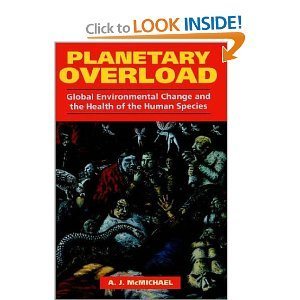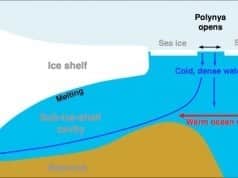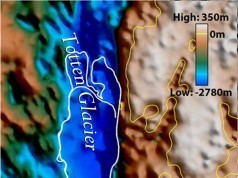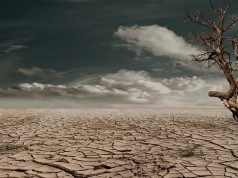Some people think early editions of the Intergovernmental Panel on Climate Change (IPCC) report were scrupulously science-based, but that the process became more politicized in recent years. A look at the first appearance of the health chapter – in the 1995 edition – challenges this view. [29-page PDF of the chapter]
The person who headed that effort was an Australian epidemiology professor named Anthony McMichael. According to a 2001 bio, his early research interests included mental health, occupational diseases, the link between diet and cancer, and environmental epidemiology (diseases). In the late 1980s he co-authored a “bestselling guide to a healthier lifestyle” that discussed nutrition and physical fitness.
The bio tells us it was only “during the 1990s” that McMichael developed “a strong interest” in the risks associated with global environmental change. So in the early 1990s, out of all the experts in the entire world the IPCC might have chosen to oversee the writing of a section dealing with climate change and human health, why was McMichael selected?
Stacking the Deck
I suspect it had a great deal to do with another book he wrote – the one that appeared in 1993 titled Planetary Overload: Global Environmental Change and the Health of the Human Species. This book’s central theme is that human activity is undermining the planet’s ecosystem. Its tone, language, and analysis are similar to hundreds of other environmental treatises published in recent decades.
McMichael declares that “humans cannot live apart from nature, remote from the great web of life.” He frets that we are too distant “from the rhythms of natural systems.” He speaks of environmental degradation as “an unprecedented moral problem” and says people in rich countries live a wasteful, “ecologically distorted lifestyle.”
His language is not the tentative sort used by dispassionate scientists. Back in 1993 he didn’t say there was concern that carbon dioxide might eventually “disrupt various of the biosphere’s natural cycles,” he confidently proclaimed that it would. Like a long line of other eco thinkers, he believes environmental challenges require a wholesale “reordering of social values.”
McMichael’s Planetary Overload arguments rely on a Greenpeace report about global warming. His book frequently cites articles in non-peer-reviewed publications such as New Scientist and Scientific American. McMichael is, in other words, an environmentalist whose day job happens to involve the study of public health. He has no expertise in most of the topics his book discusses.
He is, of course, entitled to his personal opinions. But was he the best choice to lead an IPCC chapter? Let’s rephrase that: if one wished to deliberately stack the deck, to ensure that a certain perspective would dominate the climate bible’s first health chapter, would someone who had expressed views similar to McMichael’s not have seemed like the perfect candidate?
There is a straight line between what the UN’s 1995 climate bible told the world about health issues and what McMichael had already written in his 1993 book. Although Planetary Overload isn’t included among the 182 references listed at the end of the health chapter, entire passages of the climate bible were lifted directly from it. A selection appears below:
McMichael’s 1993 book, page 150:
Sandstorms in Kansas (USA) and in the Sudan have been accompanied by increased illness and death from bronchitis and asthma.Climate Bible’s 1995 Working Group 2 report, page 578:
Sandstorms in Kansas (USA) and the Sudan have been accompanied by increases in bronchitis and asthma.
McMichael’s 1993 book, page 155:
In Egypt, for example, the water snails tend to lose their schistosome infections during the winter months (January-March). However, if temperatures increase, snails may spread schistosomiasis throughout the year, thus increasing the already heavy parasite burden in rural Egypt.Climate Bible’s 1995 Working Group 2 report, page 574:
In Egypt, for example, water snails tend to lose their schistosome infections during winter, but if temperatures increase, snails may mediate schistosomiasis transmission throughout the year.
McMichael’s 1993 book, page 155:
Arboviral infections span a wide clinical spectrum, from those that cause mild feverish illness or subclinical infections to those causing severe and often fatal encephalitis (brain inflammation) or hemorrhagic fever. Under favourable environmental conditions, an arboviral disease can become epidemic (population-wide), from a local endemic base – in much the same way that cholera has recently broken out.Climate Bible’s 1995 Working Group 2 report, page 575:
Arboviral infections span a wide clinical spectrum, from those that cause mild feverish illness or subclinical inflections to those causing severe and often fatal encephalitis (brain inflammation) or hemorrhagic fever. Under favorable environmental conditions, an arboviral disease can become epidemic (population-wide), from a local endemic base or by its introduction to a previously unaffected area.
McMichael’s 1993 book, page 154:
In eastern Africa, a relatively small increase in winter temperature would enable the malarial zone to extend ‘upwards’ to engulf the large urban highland populations that are currently off-limits to the mosquito because of the cooler temperatures at higher altitudes – e.g. Nairobi (Kenya) and Harare (Zimbabwe). Indeed, such populations around the world, currently just outside the margins of endemic malaria, would provide early evidence of climate-related shifts in the distribution of this disease.Climate Bible’s 1995 Working Group 2 report, page 574:
Hence, it is a reasonable prediction that, in eastern Africa, a relatively small increase in winter temperature could extend the mosquito habitat and thus enable faciparum malaria to reach beyond the usual altitude limit of around 2,500 m to the large, malaria-free, urban highland populations, e.g. Nairobi in Kenya and Harare in Zimbabwe. Indeed, the monitoring of such populations around the world, currently just beyond the boundaries of stable endemic malaria, could provide early evidence of climate-related shifts in malaria distribution.
McMichael’s 1993 book, page 165:
Already in Africa, there are over 100 million people who are ‘food insecure’, many of them in the arid Sahel region, home to approximately 35 million people.Climate Bible’s 1995 Working Group 2 report, page 577:
Already in Africa, more than 100 million people are “food insecure,” many of them in the arid Sahel region.
McMichael’s 1993 book, page 166:
A rise in temperature could also have significant effects on the growth and health of farm animals. Young animals are less tolerant of a wide range of temperature than are adult animals.Climate Bible’s 1995 Working Group 2 report, page 577
An increase in temperature and temperature extremes could also affect the growth and health of farm animals; young animals are much less tolerant of temperature variation than are adult animals.
McMichael’s 1993 book, page 166:
With respect to adverse effects on livestock, the U.S. Environmental Protection Agency has identified several infectious diseases – such as the horn fly in beef and dairy cattle and insect-borne anaplasmosis infection in sheep and cattle – which might well increase in response to climate changes.Climate Bible’s 1995 Working Group 2 report, page 577:
For example, the U.S. Environmental Protection Agency has identified several infectious diseases – such as the horn fly in beef and dairy cattle and insect-borne anaplasmosis infection in sheep and cattle – that could increase in prevalence in response to climate changes.
McMichael’s 1993 book, page 187:
UNEP predicts that an average 10% loss of ozone (such has become established at middle-to-high latitudes in recent years), if sustained globally over three-four decades, would cause at least 300,000 additional cases of non-melanocytic skin cancer worldwide each year and 4,500 extra cases of malignant melanoma – and possibly double that figure.Climate Bible’s 1995 Working Group 2 report, page 578:
The UN environment Programme predicts that an average 10% loss of ozone (such as occurred at middle-to-high latitudes over the past decade), if sustained globally over several decades, would cause approximately 250,000 additional cases of [nonmelanocytic skin cancers] worldwide each year.
It appears unlikely that a good faith, bona fide review of the scientific literature took place prior to the writing of significant sections of the IPCC’s first health chapter. Instead, the climate bible surreptitiously incorporated numerous opinions expressed a few years earlier by the activist-oriented person in charge of writing this chapter.
Then the media told the world that the IPCC’s proclamations regarding global warming and diseases such as malaria were the considered, consensus view of thousands of experts.






